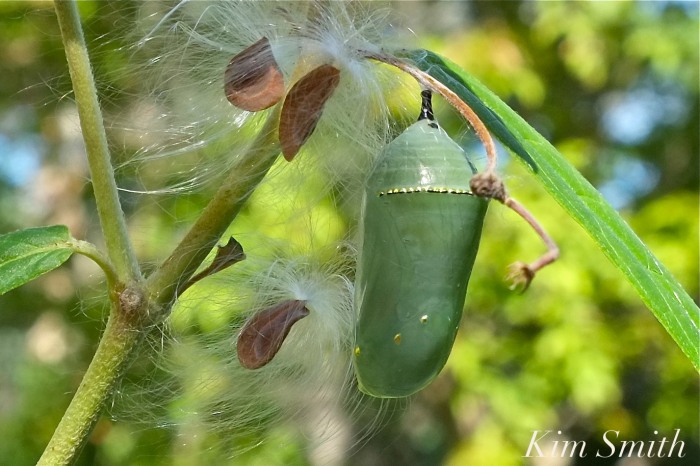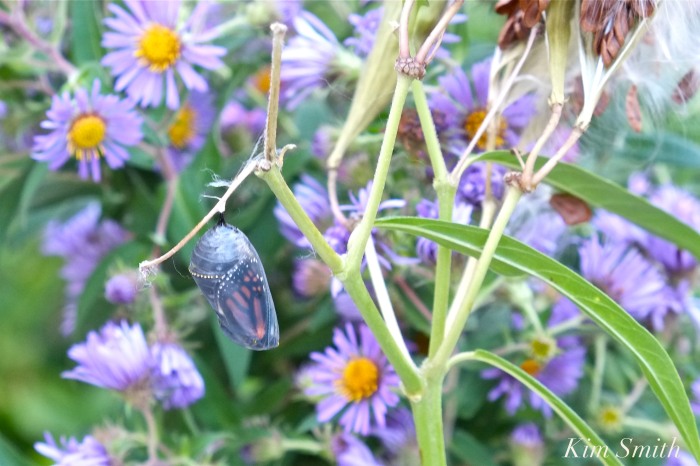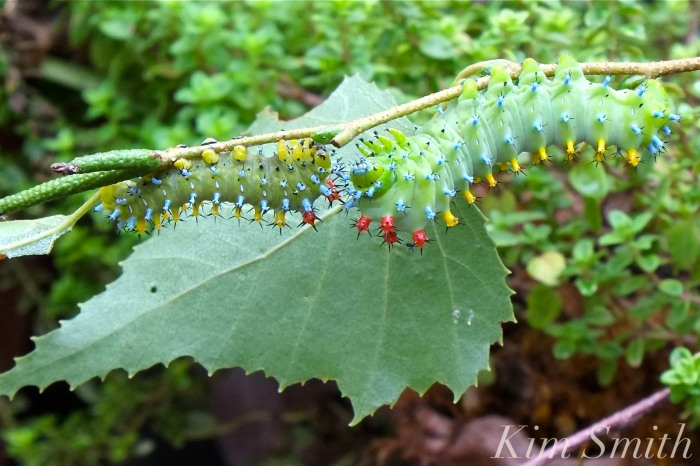Dear Friends,
Please join me April 6th at 7pm, at the Sawyer Free Library where I will be giving my Pollinator Garden talk and screening several short films. The event is free and open to the public. I am looking forward to presenting this program at our wonderful Sawyer Free and hope to see you there!!
 Thank you to Diana Cummings at the Sawyer Free Library for making the lovely poster!
Thank you to Diana Cummings at the Sawyer Free Library for making the lovely poster!

Echinacea and Bee
Spread The GMG Love By Sharing With These Buttons:
Related
Published by Kimsmithdesigns
Documentary filmmaker, photographer, landscape designer, author, and illustrator. "Beauty on the Wing: Life Story of the Monarch Butterfly" currently airing on PBS. Current film projects include Piping Plovers, Gloucester's Feast of St. Joseph, and Saint Peter's Fiesta. Visit my websites for more information about film and design projects at kimsmithdesigns.com, monarchbutterflyfilm.com, and pipingploverproject.org. Author/illustrator "Oh Garden of Fresh Possibilities! Notes from a Gloucester Garden."
View all posts by Kimsmithdesigns
 Thank you to Diana Cummings at the Sawyer Free Library for making the lovely poster!
Thank you to Diana Cummings at the Sawyer Free Library for making the lovely poster!







Hi Kim,
We appreciate your work on behalf of our hard working pollinators. Keep up the good work.
I’m concerned about noxious plant seed contained in quite a few pollinator seed mixes. This includes about 60% of the mixes used in the Conservation Reserve Program (CRP), a federal farm program (reference here is a study by a graduate student at U. Missouri). The worst culprit is Palmer amaranth, a plant that can produce as many as a million seeds per plant and is terribly resistant to most herbicides. It can reduce crop yields so much as to bankrupt a farm (and has done so, mostly in the southern states so far). Since the seeds can be spread by waterfowl, seeds from barely agricultural states can find their way to places where agriculture is the most important part of the economy.
OK, I just cleared a couple of acres of land that isn’t feasible for crop farming and would like to provide better pollinator habitat. Do You know of a source of seed that is certified to not contain Palmer amaranth, or for that matter waterhemp or any other form of pigweed? I’ve been searching the web, and have come up empty handed. I just can’t bring myself to plant seed that has a better than 50% chance of really messing up our farm. We do have 17 bee colonies at the next door farm, and they are doing quite well with the plants they find nearby. From a farming point of view, they seem to be taking care of us. However, I worry about other pollinators.
I know this is a long shot, but I thought I’d ask as you have been so knowledgeable about pollinators.
Thank you!
LikeLiked by 1 person
Hi Bob, Just a quick question before I check sources, but have you thought of making your own mix? Also, what time of year would you most often be enjoying your new meadow?
LikeLike
We already have a small amount of milkweed, whatever variety I’m not sure of, but I am grateful for that. And a lot of little yellow wildflowers that I can’t identify, maybe buttercups? I don’t think we have a great variety, just whatever has thrived over the years, and that is what concerns me, as it doesn’t seem all that diverse. Unfortunately, we live about 90 miles from the farm which makes frequent tending a bit difficult, let alone seeding. We are prone to lengths of too wet/too dry, so if I put something in the ground, we lose a lot along the way…we have no water other than rain. With our infrequent visits to the farm, I don’t have a favorite season, I just want to see the habitat sustaining the wildlife. I’ll try just about anything but really need to avoid the “bad” seeds. We have a pretty good loam soil. But pretty bad heat and cold from time to time. More extreme than eastern Massachusetts, on average. Thanks.
LikeLiked by 1 person
Starting a wildflower meadow sounds easy, but it is really a project that needs a good amount of attention, especially at the onset. I think the best thing to do would be to start out very small, a little experiment. I had a friend (he passed away) who had a farm and in the midst of his grazing field he created a small wildflower patch, located next to the only tree on the farm, and adjacent to a small pond.
There is a gorgeous field in Rockport, Waring Field. Mostly what grows there is red clover. Milkweed and other wildflowers come up in the field and around the perimeter are patches of asters and goldenrod. What if you started by seeding the field with red clover, which bees and butterflies love (and clover also improves the soil), and keep one small area to develop an experimental wildflower and native grass patch. Once you find what works best, the wildflower meadow could be expanded.
You have such an excellent resource in the Missouri Botanical Garden. From their website:
With a trend towards establishing more naturalized landscapes, planting a meadow garden is becoming popular amongst gardeners who have learned to appreciate the array of colors, textures and simple beauty. In Nature, wildflower meadows are not created overnight. Much hard work and patience is needed to grow a meadow garden in your yard which will flower year after year. Here’s how to do it.
To begin, you must select the proper site; initially, think small! Frequently, meadow gardening is discussed in terms of acres, but for most home gardeners, this is impractical. An area ranging from 100 to 2000 square feet is a good, manageable size. The site should have full sun, be well drained and have good soil structure. Soil structure, is very important for the formation of deep roots, which help plants survive the long dry summers.
When you begin the process of selecting plants for the meadow, acquire a good list of Missouri native wildflowers and grasses. The Missouri Department of Conservation’s list also includes Midwest seed sources. Consider height, bloom period and color of each selection. In nature, meadows are comprised mostly of grasses which function to prevent soil erosion, invasion of weeds and stabilize the wildflower population from blowing over in the wind. They also provide a nice contrasting background for the wildflower’s color.
Up to 2000 square feet, limit your choices to a total of six to eight different kinds of wildflower and grass plants. Approximately 60% of the mix should be grasses and 40% wildflowers. You will need a little less than a quarter of a pound of seed per 1000 square feet.
Prepare the site for seeding, by clearing existing vegetation. The best time to start the process is in the fall. Till over the entire area to a depth of four-to-six inches. In early spring, newly emerging weeds should be tilled-in approximately every two weeks up until planting time, late March or early April. You can use a broad spectrum herbicide to clear out the weeds. However, a well-tilled soil is extremely important for good seed germination and plant establishment. Do not skip this step!
Once the site is prepared and smoothed over, you are ready to plant. Planting time is very important. The ideal time is: after the ground has thawed and before the spring rains, when the weather is cool. Seed can be broadcast by hand. Because the seeds are very small, it is a good idea to mix seed with sawdust or sand so the seed can be spread evenly. Cover the seed with a light layer of soil by shallow raking with the back of the rake. Place a board over seed, and step on it to firm the soil, ensuring good soil to seed contact.
Weeds can be a problem in the first year because wildflower plants initially spend more time growing roots than leaves. Uncontrolled weeds can choke-out the wildflowers. Old fashion hand pulling is one remedy. This means hard work to stay ahead. If you prefer this method, be sure that you recognize which is a weed and which is a wildflower. Grow some of your selections in pots so you recognize the seedlings. If the weeds do get out of control, you can mow the area at a height of 6 to 8 inches, two-to-three times during the summer.
The site should begin to resemble a meadow by the second year. After the second year, and every three-to-four years after the flowers have set seed, the meadow should be mowed to 6 to 8 inches high and the loose vegetation composted. Natural meadows are renewed by burning; which will either require a permit or may be prohibited altogether, depending upon where you live. Burning kills woody plants, weakens weed seeds and breaks down the organic material, preventing self sown seeds from reaching the soil surface to germinate.
As a last note, use fertilizer cautiously. Use of a fertilizer high in nitrogen can result in abundant foliage growth at the expense of flowers.
LikeLike
Thank you so much for your work on this; it is a lot more than I would expect from anyone. I do expect to start small, and my new two acres is a big patch that I would not attempt to manage on my own, especially since I live so far from the farm. I was figuring on a couple of hundred square feet, where I can bring a small tiller and other tools; we have no structures in which to store equipment. I had a Mo Dept of Conservation agent visit the farm three years ago, and he provided a good deal of info as to how to manage our excess acreage for wildlife (think mostly quail, hopefully pheasant, and other critters of the land). But he had little to say about pollinators. I have tried to find stuff on the MDC web site, and while it has links to local seed providers, so far those providers web sites don’t say anything about weed content. Even buying a single species of seed, the sellers have nothing to say about noxious weed content. It could be that I need to wait a year or two, as I’ll bet Conservation Reserve Program seed requirements will change to reflect the threat and the seed guys will have to respond. I can ask seed sellers now, but they may not reasonably be able to tell me what is in their seed; analysis is a pretty specialized task, and I’ve never seen a seed mix for anything that didn’t have some contaminants. I’m willing to live with some undesirable plants, but not Palmer. Thanks for reminding me about the Mo Botanical Garden, which indeed is a wonderful resource which I had not thought about, since it is in St. Louis, “Shaw’s Garden” in local terminology, and a great place to visit, and just out of my “resource” thoughts due to its distance. I think I will make a specific inquiry with them. Well, you have me thinking a lot more about my plan. I’ve already committed to thinning the woodland acres, and doing controlled burns every three years, and such. If I can tuck a pollinator garden in there, I’ll be a happy guy.
Thanks again, this has been very helpful.
Bob
LikeLike
Very nice and what a way to complete the circle of life vital to have! What a lesson too how much everything contributes to the outcome of life! 🙂 Dave & Kim 🙂
LikeLiked by 1 person
Thanks so much Dave 🙂
LikeLike